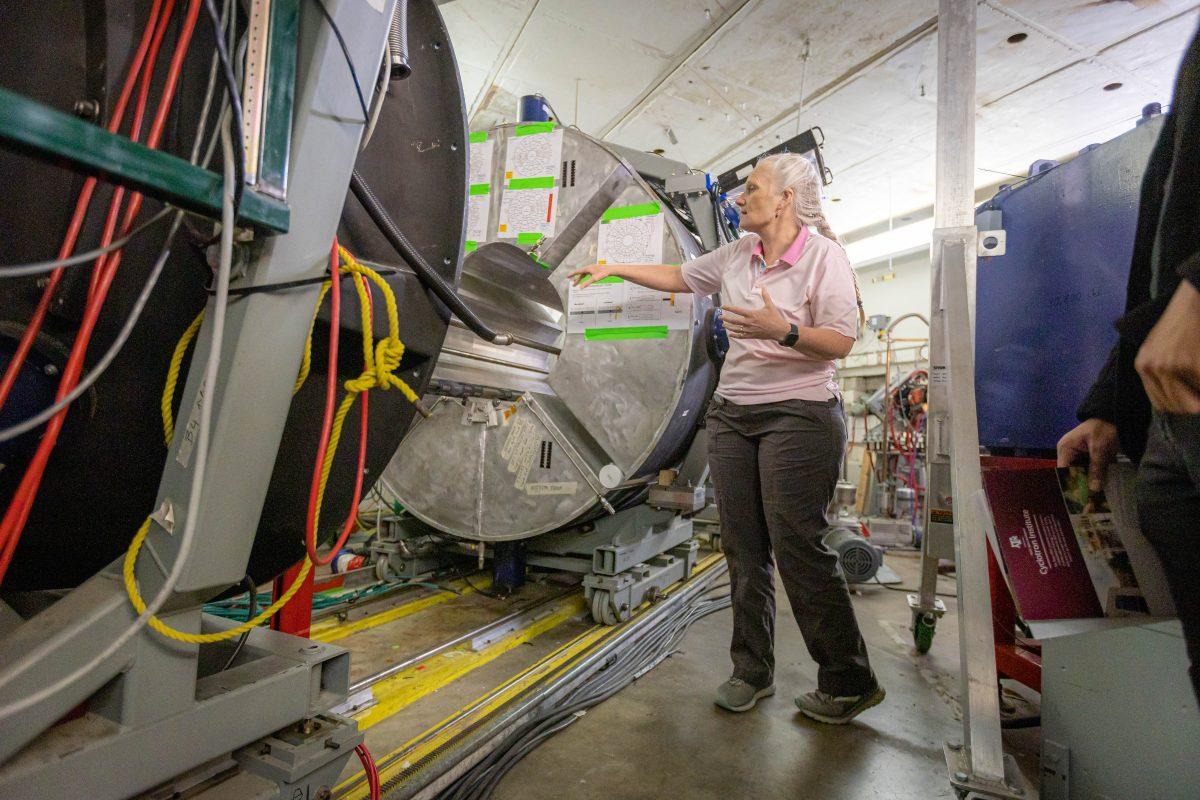Tucked away between the Zachry Engineering Education Complex and the Mitchell Physics Building is the Texas A&M Cyclotron Institute. Closed to the public and most students, beneath the building’s brown brick exterior is one of the world’s most sophisticated collections of particle colliders.
The Cyclotron Institute was founded in 1967 with the goal of researching the fundamental physical properties of the universe, said Sherry Yennello, Ph.D., professor of chemistry and director of the institute.
“From purely trying to understand how the world works, then you’ve got to understand these fundamental basic physics,” Yennello said. “What’s the relationship between these elements, how are they formed?”
An example of such fundamental research is the work of Alan McIntosh, Ph.D., an assistant research scientist at the institute. Alan is investigating the process by which iron-60, a mysterious isotope, or atomic configuration, of iron is formed. While iron always has 26 protons, the number of neutrons varies. Iron-60 has 34 neutrons, the 60 denoting the sum of the protons and neutrons.
“Iron-60 has got a half-life of two and a half million years,” Alan said. “Sounds like a long time, but the solar system is about four and a half billion years old. Any iron-60 that was around when the solar system was created should be long gone by now, but we find iron-60. You have to look hard for it, but we found it in ocean sentiments, Antarctic snow … They found iron-60 in samples from the Apollo missions they brought back.”
In order to create iron-60, Alan said he first creates iron-59, a highly unstable isotope of iron, by accelerating iron-58, a common, stable isotope of iron using the cyclotron facilities.
“Iron-56, 57, 58 are all stable isotopes. We want to make a beam of iron 59, which doesn’t exist in nature, so we have to start with something else. The one we’ve decided to go with is we start with iron-58,” Alan said. “We put some iron-58 metal in our ion source, accelerate that with our cyclotron to about 12 and a half MeV per nucleon. That’s something like 20% the speed of light … It’s going pretty fast.”
The accelerated iron-58 is collided into a neutron source, Alan said, in this case deuterium, an isotope of hydrogen with one neutron in addition to the one proton.
“We smash it into our primary target, which is going to be a bunch of deuterium gas inside of small cell rows,” Alan said. “Most of the time, it will go straight through — the atom is mostly empty space, but some of the time it will collide with the deuterium and make something new. Most of that something is garbage, but a small fraction of that will be iron-59, where iron-58 has picked up a neutron from the deuterium.”
From there, Alan said the process is repeated to form iron-60.
“Now you’ve got iron-59 spraying off from that reaction site downstream,” Alan said. “We won’t pick up all of it, but we can pick up a good fraction of it. We have a spectrometer … It will filter out most of the junk and keep most of the good stuff, most of the iron-59. Then we have a beam of iron-59 … We impinge that on another deuterium target … again, most of the time, the iron-59 goes straight through because the atom is mostly empty space, but some of the time you get the reaction of interest. Then we can create the iron-60.”
The most promising theory of the origin of iron-60 on Earth, Alan said, is outer space.
“The idea is that iron-60 is being produced in the core of certain types, asymptotic giant branch stars, late in their life cycle at a particular layer in their structure, most of the way down,” Alan said. “Then the star explodes, releasing its iron-60 out into the environment around it. Eventually, our solar system goes through that region of the galaxy, and we get iron-60 raining down on us like bugs on the windshield. We want to understand the production of iron-60 so that we can make our models of stellar evolution better.”
Alan said while lighter elements can be formed by stellar fusion, other processes are necessary to form heavier elements.
“Elements are made in a variety of processes in the universe,” Alan said. “In stars, you have hydrogen burning our sons burning hydrogen into helium. Later in its life, it’s going to fuse helium into carbon and oxygen and work its way up heavier and heavier elements. That’ll get you up to iron, and the whole rest of the table, beyond iron, you can’t access by fusion. It’s not energetically favorable and won’t happen.”
Learning more about the mechanisms by which elements are formed in particle accelerators, Alan said, provides clues into the mechanisms behind the formation of atoms in the high energy environments of supernovae, which created nearly all the heavy elements seen in daily life.
“Those elements are created and much more violent processes: stars explode, they release huge energy that fragments nuclei, and you have a whole bunch of free neutrons kicking around,” Alan said. “If you want to understand how elements are made, you need neutron capture.”
While fundamental research was the original focus of the Cyclotron Institute, Yennello said the institute has recently been putting its facilities to use toward creating medical applications.
“Besides the fundamental research that we do here … we make medical isotopes,” Yennello said. “The Department of Energy came to us and said, ‘You have a machine that has 28.8 MeV alpha particles. Would you try to figure out if you could make astatine?’”
Astatine is a rare and highly radioactive heavy element with an isotope astatine-211 that is of particular interest to the researchers. While the instability of astatine-211 makes it difficult to work with, as half of a given mass of astatine-211 will decay into lighter elements in 7.2 hours, Lauren McIntosh, Ph.D., an assistant research scientist at the institute, said the the unique radiation properties of astatine-211 make it a promising candidate for cancer treatment.
“Astatine-211 is an interesting isotope, because … it decays completely by alpha emission,” ,” Lauren said. “Of the different kinds of radiation that you could have from a radioactive nucleus, alpha [particles] have the highest energy transfer and the shortest range. We find that helpful, because types of radiation therapy that happen now for cancer treatment tend to be very destructive. If you could get something that had a greater capability for killing cancer cells and a lesser range so it wouldn’t kill as much healthy tissue, that can be really good.”
The institute, Lauren said, is partnering with the MD Anderson Cancer Center and the University of Alabama at Birmingham to study the effects of astatine-211 treatment. A&M’s facilities create the astatine-211 and collaborators to perform the medical research.
“The way that we packaged the astatine works for an overnight shipment, which means that we can have a larger range of the sort of the places that we can impact, the people who will be able to do research with the isotope that we’re producing here,” Lauren said. “You pack up a lot more than what gets there … By the time it’s gone overnight, you’re down to maybe 10% of what you shipped, so we pack up a larger column for UAB than we do for MD Anderson.”
On the more fundamental side, Lauren said the institute’s ability to create astatine, nearly nonexistent in nature due to its instability, presents the possibility of studying the chemistry of the element.
“On the periodic table there’s this line in between metals and nonmetals, and things that are on that line have slightly metallic properties and kind of not metallic properties,” Lauren said. “Astatine is right on that line. So whether it behaves more like the halogens above it, or more like a metalloid, or a metal, to the other side of the line is an open question because it just hasn’t been studied very much, because it’s very rare.”
Yennello said such potential applications of nuclear science are a deep source of motivation for her and her team.
“The astatine work, I think, is really important,” Yennello said. “It’s different because it’s not along the lines of what we’ve been doing for 50 years, 60 years here. But it [is] also really touch[ing]. I don’t know if I know anybody who, somewhere in their family, friends circle hasn’t been touched by cancer. If we can help bring this isotope to market in a way that can treat cancer, to give people a better quality of life, a longer life — it just — it would be incredible.”
















